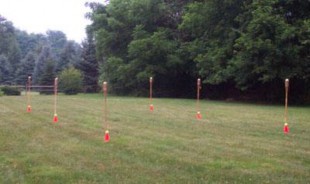
< Previous | Contents | Manuals Home | Boris FX | Next >
SynthEyes includes the powerful capability of allowing multiple shots to be loaded simultaneously, tracked, linked together, and solved jointly to find the best tracker, camera, and (if present) object positions. With this capability, you can use an easily-trackable “overview” shot to nail down basic locations for trackable features, then track a real shot with a narrow field of view, few trackable features, or other complications, using the first shot as a guide. Or, you might use a left and right camera shot to track a shot-in-3-D feature. If you don’t mind some large scene files, you can load all the shots from a given set into a single scene file, and track them together to a common set of points, so that each shot can share the same common 3-D geometry for the set.
Note : although stereo is a form of multi-shot tracking, multi-shot tracking is not necessarily stereo. Stereo shots require that both eyes be synchronized, have the same image size, aspect, and length (and of course there must be only two of them). When a shot is stereo, special additional features and tools are available that are not available to general multi-shot setups.
In this section, we’ll demonstrate how to use a collection of digital stills as a road- map for a difficult-to-track shot: in this case, a tripod shot for which no 3-D recovery would otherwise be possible. A scenario such as this requires supervised tracking, because of the scatter-shot nature of the stills. The tripod shot could be automatically tracked, but there’s not much point to that because you must already perform supervised tracking to match the stills, and there’s not much gained by adding a lot more trackers to a tripod shot. It will take around 2 hours to perform this example, which is intentionally complex to illustrate a more complex scenario.
The required files for this example can be found at https://www.ssontech.com/download.html: both land2dv.avi and DCP_103x.zip are required. The zip file contains a series of digital stills, and should be unpacked into the same working folder as the AVI. You can also download multix.zip, which contains the
.sni scene files for reference.
Prerequisites : You need to be able to do supervised tracking , create survey shots , and handle coordinate system setup for this description; it does not contain a beginner-level description.
Start with the digital stills, which are 9 pictures taken with a digital still camera, each 2160 by 1440. Start SynthEyes and do a File/Add Survey Shot. Add the DCP_####.JPG images.

Create trackers for each of the balls: six at the top of the poles, six near ground level on top of the cones. Create each tracker, and track it through the entire (nine- frame) shot using the survey-shot workflow. You can use control-drag to make final positioning easier on the high-resolution still. Create the trackers in a consistent order, for example, from back left to front left, then back right to front right. After completing each track,
Lock ![]() the tracker.
the tracker.
The manual tracking stage will take less than an hour. The resulting file is available as multi1.sni.
Set up a coordinate system using the ground-level (cone) trackers. Set the front- left tracker as the Origin, the back-left tracker as a Lock Point at X=0,Y=50,Z=0, and the front-right tracker as an XY Plane tracker.
You can solve for this shot now: switch to the Solver panel and hit Go! You should obtain a satisfactory solution for the ball locations, and a rather erratic and spaced out camera path, since the camera was walked from place to place. ( multi2.sni)
It is time for the second shot. On the Shot menu, select Add Shot ( or File/Import/Shot). Select the land2dv.avi shot. Set Interlacing to No; the shot was taken was a Canon Optura Pi in progressive scan mode.
Bring the camera view full-screen, go to the tracker panel, and begin tracking the same ball positions in this shot with bright-spot trackers. Set the Key spinner to 8, as the exposure ramps substantially during the shot. The balls provide low contrast, so some trackers are easiest to control from within the tracker view window on the tracker panel . The back-right ground-level ball is occluded by the front-left above-ground ball, so you do not have to track the back-right ball. It will be easiest to create the trackers in the same order as in the first shot. ( multi3.sni)
Next, create links between the two sets of trackers, to tell SynthEyes what trackers were tracking the same feature. You will need a bare minimum of six (6) links between the shots.
©2024 Boris FX, Inc. — UNOFFICIAL — Converted from original PDF.